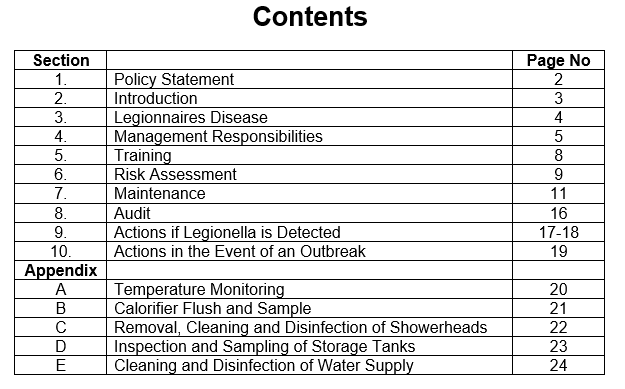What is Legionella?
Legionella is a form of bacteria that is commonly found in natural and artificial water systems, such as cooling towers, hot tubs and potentially any system that contains water plumbing systems. All man-made hot and cold water systems are likely to provide an environment in which Legionella can grow if not managed correctly. In poorly managed systems the bacteria may also multiply in more favourable conditions, thus increasing the risk of exposure.
How to prevent Legionella outbreaks
As a landlord or property owner, it is your responsibility to assess any potential sources of Legionella bacteria growth and introduce control measures that seek to prevent further growth and limit risk to tenants, customers and employees.
Here are 5 best practices to prevent a Legionella outbreak and keep everyone safe.
1.Implementation a control scheme
The written scheme of control is not a Legionella Risk Assessment and is for the prevention and control of the risk. The document should be used to ensure everyone involved in any related operational procedure undertakes their duties properly. It should define staff responsibilities and lines of communication and ensure there is sufficient staff available during the hours of operation. The precise requirements will depend on the nature and complexity of the water system. The contents table below can be used as a guide as to what should be considered and included within your written scheme of control.

2. Conduct a Legionella risk assessment
Conducting a Legionella risk assessment is something that you are legally obligated to do as a landlord. That said, it is an important thing to do regardless, as it provides a source of information in regards to controlling the spread of legionella within the premises and highlights any gaps in the water system maintenance that could be addressed. Read our ultimate guide on Legionella risk assessments for more guidance.

3. Maintain correct water temperatures
Legionella thrives in warm water, so if you are using temperature as a control, keeping a controlled water temperature in both hot and cold water systems is essential. As well as maintaining the correct water temperatures, you should be wary of stagnant water. Water that sits in pipes or storage tanks can become a hot spot for Legionella bacteria. Be sure to flush your water systems regularly and avoid any dead legs in your water systems.
4.Maintenance and management
One of the best ways to prevent the presence and growth of Legionella is to consider the risk in all aspects of the water system design. When all of the risks are understood and considered, proper maintenance for the water systems can be coordinated amongst the staff. In order to best minimise risk, you may want to consider the following:
- Remove any redundant plant or pipework so no water can stagnate
- Ensure your system is properly designed for the usage, any tanks should be suitably sized so they are turned over once every 24 hours during normal use.
- Adequate pipe and tank insulation
- Use WRAS approved materials that minimise the growth of Legionella
- Educate employees on the risks of Legionnaires’ disease and how to reduce the risk of exposure

5. Educate your staff
It’s important to train and educate your staff on the necessary water management and maintenance necessary for Legionella prevention. Employees should also be aware of any and all Legionella control measures in place. If all staff and tenants are aware of the risks associated with Legionella bacteria and the symptoms of Legionnaires’ disease, this can further prevent exposure.
A Comprehensive Approach
Preventing a Legionella outbreak requires a comprehensive approach; including regular testing, maintenance and training. For more information on our Legionella management and monitoring schemes, speak to our specialist on our team.
 ASBESTOS REGULATION COMPLIANCE CHECKER
ASBESTOS REGULATION COMPLIANCE CHECKER 0191 419 3116
0191 419 3116 contactus@franksportlock.co.uk
contactus@franksportlock.co.uk








